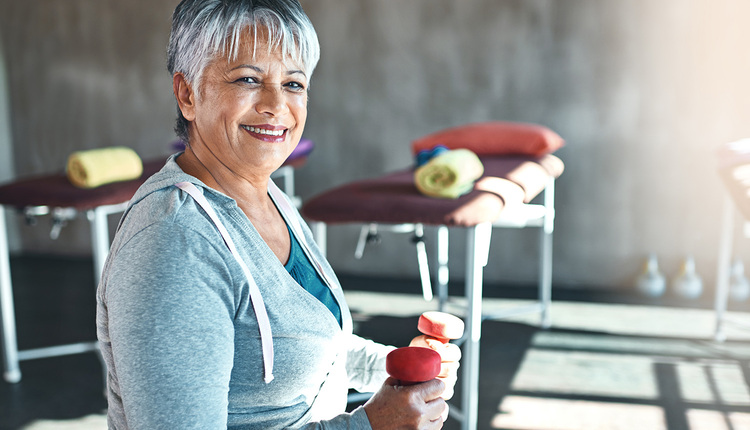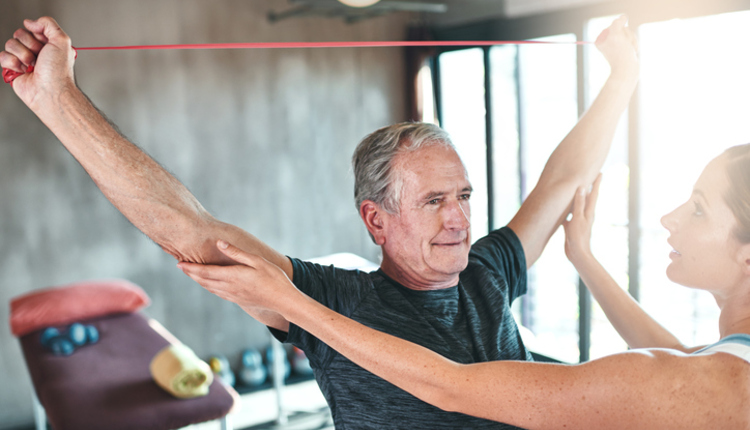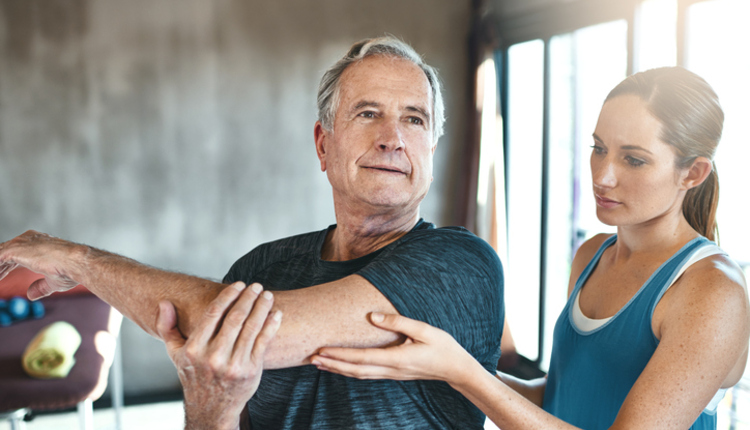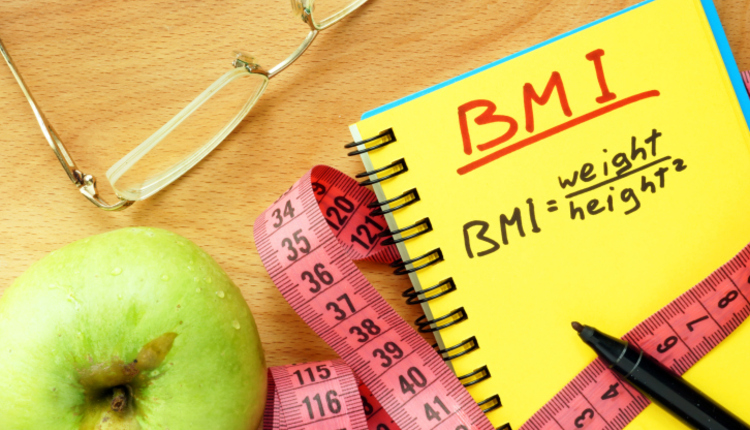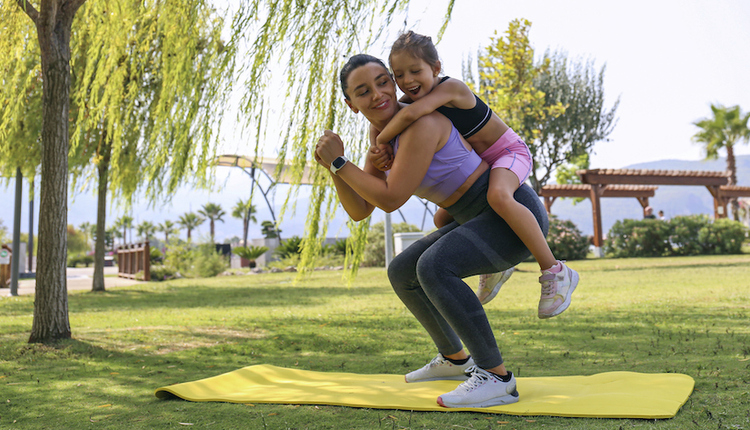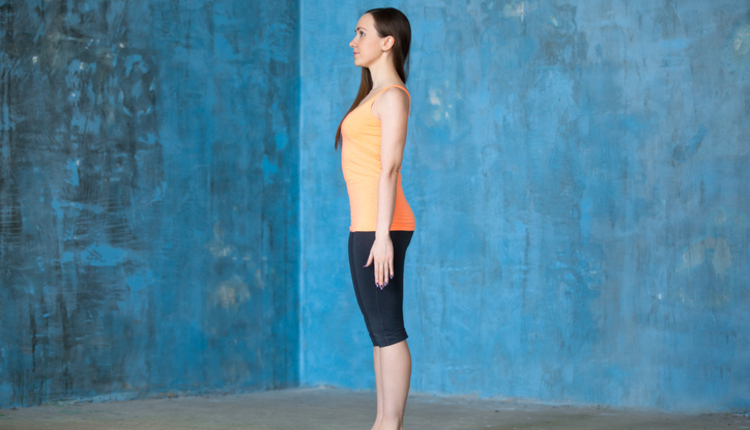
Fitness professionals are in a position to prevent and improve poor posture. We know good posture allows for efficient movement while poor posture can cause some muscles to work too hard and others too little, causing imbalances and resulting in some muscles becoming very weak and some too tight. This ultimately stresses the joints which can eventually cause pain and poor range of motion.
Many years ago a physical therapist told me that half of his business is attributable to his clients having posture dysfunction. As desk jobs increase, the number of people with good posture decreases. Sadly, poor posture is now developing at younger and younger ages and is being observed even in our middle school population. Kyphosis is a prevalent condition; one has a forward head, tight pectoral muscles and weak back muscles. I suspect that as a result, neck and back pain will develop at younger ages. This is partially due to the prevalence of handheld devices causing one to jut the head forward in order to read the screen and spending a lot of time sitting in front of a computer. Using the computer all day leads to a rounding of a person's back and causes their chin to go forward. The way we position ourselves at our desk or on our sofa can also lead to poor posture and imbalances.
As we age, it is typical for the shoulders to round and to develop a head forward position. When one has a head forward position, the affected vertebrae can harm the disks and compress the surrounding nerves. The vertebrae need to be properly aligned so when the posture is improved there will be less compression on the nerves, thereby decreasing pain.
Poor posture can create muscle tightness and shortening which can also press on nerves causing pain. Some back and neck discomfort can be alleviated through posture improvement. Posture issues should be seen by a physical therapist, posture specialist or doctor.
There are significant benefits to having good posture, primarily, efficient movement. Other benefits include potential improvements in strength, balance and a decreased chance of muscle strain, tendonitis and bursitis. Proper posture will allow you to move with more freedom and make you feel more confident.
So how can we as fitness professionals help prevent all the orthopedic issues that are exacerbated by poor posture? A posture assessment should be done monthly in both a standing position and during physical activity. I have found that the best way to conduct the standing assessment is to have the client stand against the wall and be assessed from a front, back and side view. Clothing needs to be form fitting in order to do an evaluation. The head, upper back and buttocks should touch the wall. Look at the head placement. Is the ear in-line with the shoulder? The shoulder blades should lie flat without winging, and the shoulders should not round forward and should be over the hip. The ribcage should be over the pelvis and the chest open. The front of the hip bones should be over the pubic bones. The hips should be over the ankle joint and the knees should not be hyper-extended or flexed.
Is there a lot of space between the head and the wall? This is head forward posture. Head forward posture or kyphosis is where the upper back curves forward. This usually goes hand-in-hand with a weak upper back, especially around the scapula. The pectoral muscles are usually tight in this condition.
Is there a lot of space between the lower back and the wall? This is lordosis - where the lower back curves too much. Strengthening the core can help as will stretching the hip flexors. There are other postural dysfunctions but kyphosis and lordosis are the most common issues.
After the static assessment, watch your client in motion. Have the client walk around the room in order to check their gait. The heel of one foot should hit the floor as the other ball of the foot is pushing off. Check for plantar and dorsi flexing of the ankle. Watch how your clients perform squats and other exercises.
The fitness professional can help prevent posture problems and improve existing conditions. Once problems are detected the fitness professional should customize an exercise program with the goal of correcting imbalances. The right strengthening of weak muscles and stretching exercises can help prevent pain due to poor posture. It can help improve balance and prevent injuries.
Posture improvement is also in the hands of your client. Even if you work with your client on the stretches and strengthening exercises several times a week, you need to persuade them that they must think good posture every day. It is also a good idea to teach the client to always be mindful of their posture and to instruct them on proper ergonomics. They may have to make some lifestyle changes. These changes could include changes in their sleeping position and mattress. You need to stress that they should try not to carry a heavy bag and make sure that their desk and chair are the right height. I show my clients streches that can implement throughout the day. I remind them to always think about sitting and standing up tall with shoulders down and back.
Your clients will be motivated by the effects of good posture: appearing taller, younger, thinner and confident. Your clients will also be thrilled to have less pain and better athletic performance.
Carol Michaels is a Cancer Exercise Specialist, speaker and studio owner. She is the creator of the Recovery Fitness cancer exercise program, which has helped hundreds of cancer survivors improve their recovery from the side effects of surgery and treatments. She is nationally recognized and was identified by ACE and Life Fitness as a Trainer to Watch and is the 2012 PFP Trainer of the Year. www.recoveryfitness.net
Many years ago a physical therapist told me that half of his business is attributable to his clients having posture dysfunction. As desk jobs increase, the number of people with good posture decreases. Sadly, poor posture is now developing at younger and younger ages and is being observed even in our middle school population. Kyphosis is a prevalent condition; one has a forward head, tight pectoral muscles and weak back muscles. I suspect that as a result, neck and back pain will develop at younger ages. This is partially due to the prevalence of handheld devices causing one to jut the head forward in order to read the screen and spending a lot of time sitting in front of a computer. Using the computer all day leads to a rounding of a person's back and causes their chin to go forward. The way we position ourselves at our desk or on our sofa can also lead to poor posture and imbalances.
As we age, it is typical for the shoulders to round and to develop a head forward position. When one has a head forward position, the affected vertebrae can harm the disks and compress the surrounding nerves. The vertebrae need to be properly aligned so when the posture is improved there will be less compression on the nerves, thereby decreasing pain.
Poor posture can create muscle tightness and shortening which can also press on nerves causing pain. Some back and neck discomfort can be alleviated through posture improvement. Posture issues should be seen by a physical therapist, posture specialist or doctor.
There are significant benefits to having good posture, primarily, efficient movement. Other benefits include potential improvements in strength, balance and a decreased chance of muscle strain, tendonitis and bursitis. Proper posture will allow you to move with more freedom and make you feel more confident.
So how can we as fitness professionals help prevent all the orthopedic issues that are exacerbated by poor posture? A posture assessment should be done monthly in both a standing position and during physical activity. I have found that the best way to conduct the standing assessment is to have the client stand against the wall and be assessed from a front, back and side view. Clothing needs to be form fitting in order to do an evaluation. The head, upper back and buttocks should touch the wall. Look at the head placement. Is the ear in-line with the shoulder? The shoulder blades should lie flat without winging, and the shoulders should not round forward and should be over the hip. The ribcage should be over the pelvis and the chest open. The front of the hip bones should be over the pubic bones. The hips should be over the ankle joint and the knees should not be hyper-extended or flexed.
Is there a lot of space between the head and the wall? This is head forward posture. Head forward posture or kyphosis is where the upper back curves forward. This usually goes hand-in-hand with a weak upper back, especially around the scapula. The pectoral muscles are usually tight in this condition.
Is there a lot of space between the lower back and the wall? This is lordosis - where the lower back curves too much. Strengthening the core can help as will stretching the hip flexors. There are other postural dysfunctions but kyphosis and lordosis are the most common issues.
After the static assessment, watch your client in motion. Have the client walk around the room in order to check their gait. The heel of one foot should hit the floor as the other ball of the foot is pushing off. Check for plantar and dorsi flexing of the ankle. Watch how your clients perform squats and other exercises.
The fitness professional can help prevent posture problems and improve existing conditions. Once problems are detected the fitness professional should customize an exercise program with the goal of correcting imbalances. The right strengthening of weak muscles and stretching exercises can help prevent pain due to poor posture. It can help improve balance and prevent injuries.
Posture improvement is also in the hands of your client. Even if you work with your client on the stretches and strengthening exercises several times a week, you need to persuade them that they must think good posture every day. It is also a good idea to teach the client to always be mindful of their posture and to instruct them on proper ergonomics. They may have to make some lifestyle changes. These changes could include changes in their sleeping position and mattress. You need to stress that they should try not to carry a heavy bag and make sure that their desk and chair are the right height. I show my clients streches that can implement throughout the day. I remind them to always think about sitting and standing up tall with shoulders down and back.
Your clients will be motivated by the effects of good posture: appearing taller, younger, thinner and confident. Your clients will also be thrilled to have less pain and better athletic performance.
Carol Michaels is a Cancer Exercise Specialist, speaker and studio owner. She is the creator of the Recovery Fitness cancer exercise program, which has helped hundreds of cancer survivors improve their recovery from the side effects of surgery and treatments. She is nationally recognized and was identified by ACE and Life Fitness as a Trainer to Watch and is the 2012 PFP Trainer of the Year. www.recoveryfitness.net



